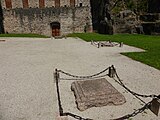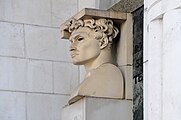Fabio Filzi

Fabio Filzi (born November 20, 1884 in Pisino , Austria-Hungary , † July 12, 1916 in Trento , Austria-Hungary) was an Italian irredentist and Austrian treason . After his execution by the Viennese executioner Josef Lang, he was stylized as an Italian national hero.
Life
Fabio Filzi was born in Istria , then part of the Austrian coast, as the son of Giovanni Battista Filzi and Amelia Ivancich. The father originally came from Borgo Sacco near Rovereto, was a professor of classical philology and initially taught at the grammar school in Pisino, then in Capodistria and later in Rovereto , with the family always accompanying him. Fabio Filzi therefore attended elementary school in Pisino, the grammar school in Capodistria in Istria and did his Matura in Rovereto in Trentino. At that time Istria and Trentino belonged to Austria-Hungary (like Lombardy and Veneto before) and were considered by Italian irredentism as areas to be liberated that were to belong to the united Italian nation-state. The tensions between the Italians from the Austrian territories and the German-speaking Austrians also erupted in 1904 at the University of Innsbruck , which led to a death, several injured and arrested among the Italian students (“ Fatti di Innsbruck ”). These events in Innsbruck sparked a series of national protests, including one in Rovereto led by Fabio Filzi. In the same year he was drafted into the 4th kuk Tyrolean Kaiserjägerregiment for military service. In 1905 he enrolled at the University of Graz to study law. The following year there were protests at this university from the Italian students in which he took part. In 1910 he received his doctorate in law in Graz. He then went first to Trieste and finally returned to Rovereto. There he worked until 1914 as a lawyer in Antonio Piscel's law firm .
First World War
He was called up after the outbreak of the First World War . Before his regiment marched to Galicia on the Eastern Front , he managed to simulate a disease during the medical visit, which is why he was transferred to another unit far from the front in the Fiemme Valley . When this unit was due to go to the front, he again faked an illness. After his supposed recovery and discharge from the hospital in Bolzano in November 1914, he was given ten days of vacation, which he used to flee to Italy. Here he joined with other irredentists for the intervention of Italy, which had declared itself neutral, on the side of the Entente . After the Italian entry into the war in May 1915, he volunteered for the Italian army .
In July 1916 he was with the Alpini Battalion Vicenza on the Pasubio in Trentino. On July 10, the battalion received the order to conquer Monte Corno (now Monte Corno Battisti ), a sub-peak of Pasubio. Fabio Filzi served the battalion as a lieutenant under Lieutenant Cesare Battisti . The attack attempt failed and Filzi and Battisti were captured by Austrian troops. While Battisti immediately identified himself as such when he was captured, Filzi gave the false name Francesco Brusarosco and was only identified by the ensign of the regional riflemen , Bruno Franceschini , who came from Trentino .
After identification, Filzi and Battisti were brought to Trento on July 11th. The next day, July 12, 1916, they were sentenced to death in the Castello del Buonconsiglio by the court of the Austro-Hungarian military station command in Trento for high treason and immediately after the conviction by the Viennese executioner Josef Lang, they were hanged on the choke barge in the northern moat of the Castello del Buonconsiglio . At the place of her execution, the Fossa dei Martiri (German: Graben der Martyrer), memorial stones commemorate this event.
The bodies of the executed Battisti, Filzi and Damiano Chiesa were buried shortly after the execution in the grounds of the Castello del Buonconsiglio. In 1935, Battisti's remains were buried in a monumental mausoleum near Trento built by Italian fascists . The bones of Damiano Chiesa and Fabio Filzi are now in the Castel Dante ossuary in Rovereto.
reception
In Italy, Fabio Filzi is a celebrated national hero and irredentist. Several schools and streets were named after him, such as the "Fabio Filzi" middle school in Laives (South Tyrol) or the "Fabio Filzi" high school in Rovereto. In 1920 the national heroes ("Protomartiri della Grande Guerra"), Cesare Battisti, Damiano Chiesa and Fabio Filzi, executed by the Austrians in 1916 for high treason, were appointed honorary members of the Accademia Roveretana degli Agiati . In the Bolzano Victory Monument from the time of fascism , Filzi was dedicated a marble pillar bust by sculptor Adolfo Wildt in 1927/28 .
The capture of Battisti and Filzi on Monte Corno in a picture by the war painter Hans Bertle ( Tyrolean State Museum )
The body Filzis after the execution, the right of the executioner Josef Lang
Memorial stones at the place of execution of Battisti, Filzi and Chiesa in the moat of the Castello del Buonconsiglio
Web links
- Silvana Casmirri: Filzi, Fabio. In: Fiorella Bartoccini (ed.): Dizionario Biografico degli Italiani (DBI). Volume 48: Filoni-Forghieri. Istituto della Enciclopedia Italiana, Rome 1997.
- Filzi, Fabio. In: Enciclopedie on line. Istituto della Enciclopedia Italiana, Rome. Retrieved August 27, 2015.
- Memorial on en.tracesofwar.com
Individual evidence
- ↑ a b c d Fabio Filzi, una breve biografia. In: filzi.it. Archived from the original on October 4, 2015 ; Retrieved on August 27, 2015 (Italian, partly identical to the biography of the Dizionario Biografico degli Italiani ).
- ↑ a b Silvana Casmirri: Fabio Filzi. In: Dizionario Biografico degli Italiani (DBI).
- ↑ Fabio Filzi on Treccani online (Italian) accessed on October 27, 2017
- ↑ a b Battisti trial file of July 12, 1916 file number 1796 / 16–1 in the original and in the Italian translation, published in 1935 (PDF; 88 MB), accessed on October 27, 2017
- ^ Entry on Filzi in the Academy's member database
- ↑ Sabrina Michielli, Hannes Obermair (Red.): BZ '18 –'45: one monument, one city, two dictatorships. Accompanying volume for the documentation exhibition in the Bolzano Victory Monument . Folio Verlag, Vienna-Bozen 2016, ISBN 978-3-85256-713-6 , p. 111-112 .
| personal data | |
|---|---|
| SURNAME | Filzi, Fabio |
| BRIEF DESCRIPTION | Italian irredentist |
| DATE OF BIRTH | November 20, 1884 |
| PLACE OF BIRTH | Pisino , Austria-Hungary |
| DATE OF DEATH | July 12, 1916 |
| Place of death | Trento , Austria-Hungary |



